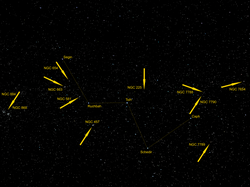NGC 654
 | |
| AladinLite | |
| Sternbild | Kassiopeia |
| Position Äquinoktium: J2000.0 | |
|---|---|
| Rektaszension | 01h 43m 59,4s [1] |
| Deklination | +61° 52′ 58″ [1] |
| Erscheinungsbild | |
| Klassifikation | II 3 m [2] |
| Helligkeit (visuell) | 6,5 mag [2] |
| Winkelausdehnung | 6′ [2] |
| Rötung (Farbexzess E(B-V)) | 0,868 [3] |
| Physikalische Daten | |
| Zugehörigkeit | Milchstraße, Cas OB8 |
| Radialgeschwindigkeit | −38,79 km/s [4] |
| Entfernung [3] | 6650 Lj (2041 pc) |
| Geschichte | |
| Entdeckt von | William Herschel |
| Entdeckungszeit | 3. November 1787 |
| Katalogbezeichnungen | |
| NGC 654 • C 0140+616 • OCl 330 • Mel 9 • Cr 18 • Lund 53 • GC 387 • H VII 46 • h 145 • | |
NGC 654 ist ein offener Sternhaufen im Sternbild Kassiopeia. NGC 654 hat einen Durchmesser von 6′ und eine scheinbare Helligkeit von 6,5 mag. NGC 654 gehört zur OB-Assoziation Cassiopeia OB8, zu der unter anderem auch NGC 663 und Messier 103 gehören.
Das Objekt wurde am 3. November 1787 von dem deutsch-britischen Astronomen Friedrich Wilhelm Herschel entdeckt.[5]

Weblinks
- Spektrum.de: Amateuraufnahmen [1][2]
- SIMBAD Astronomical Database
Einzelnachweise
- ↑ NASA/IPAC EXTRAGALACTIC DATABASE
- ↑ a b c NGC 654
- ↑ a b A site Devoted to Stellar Clusters in the Galaxy and the Magellanic Clouds
- ↑ SIMBAD-Datenbank
- ↑ Seligman
Auf dieser Seite verwendete Medien
Autor/Urheber: Bautsch, Lizenz: CC0
Das Sternbild Kassiopeia mit der Lage der Doppelsternhaufen χ Persei (NGC 884) und h Persei (NGC 869) sowie der Sternhaufen NGC 654, NGC 663, NGC 581, NGC 457, NGC 225, NGC 7788, NGC 7790, NGC 7789 und NGC 7654.
Autor/Urheber: Antonio F. Sánchez, Lizenz: CC BY-SA 4.0
NGC 654,VdB6,LDN 1332,1334,1337 (Cassiopeia) * August-September 2014 * ASA N12 astrograph (f/3.6,1078mm) * DDM85 mount * FLI ML8300 at -25ºC * Optec LRGB filter set * L.520m R:180m G:160m B:210m * Unguided *NGC 654 is a young cluster,with an age of about 14 million years.The cluster`s 80 measured members (7th magnitude and fainter) appear in little clumps scattered across a mere 6´of sky,or 14 lightyears. Astronomers have taken keen interest in NGC 654 because of it displays nonuniform extinction across its face,with stars reddened by about 1 magnitude on average.Color excess indicates the amount of interstellar reddening suffered by the light from the star when it passes through dust in space.Data from Indian Astronomer Biman J. Medhi and colleagues (2008), show evidence for the presence of at least two layers of dust along the line of sight to the cluster, which lies at a distance of about 7800 light-years.The 7th magnitude yellow supergiant star HD 10494 is a likely member of this cluster with a recessional velocity of about 31km/sec.They estimate the distances to the two dust layers to be about 652 and 3300 light-years, placing the clouds much closer to the Sun than the cluster.The foreground dust grains,appear to be responsible,then, for the nonuniform extinction towards the cluster,whose least reddened stars lie close to the cluster center.VdB 6 is a little reflection nebula. The star wrapped in vdB 6 is listed as HIP 8074 of magnitude 9.66, located in the Perseus arm, which gives the nebula a distinctly bluish color.Credits: Stephen James O´Meara"Deep-Sky Companions:The Secret Deep, Vol 4"Italian Wikipedia

